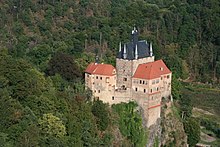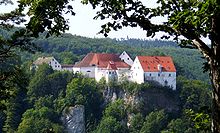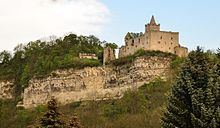
A castle is a type of fortified structure built during the Middle Ages predominantly by the nobility or royalty and by military orders.

A hillfort is a type of earthwork used as a fortified refuge or defended settlement, located to exploit a rise in elevation for defensive advantage. They are typically European and of the Bronze Age or Iron Age. Some were used in the post-Roman period. The fortification usually follows the contours of a hill and consists of one or more lines of earthworks, with stockades or defensive walls, and external ditches. Hillforts developed in the Late Bronze and Early Iron Age, roughly the start of the first millennium BC, and were used in many Celtic areas of central and western Europe until the Roman conquest.

Krak des Chevaliers, Arabic: قلعة الحصن, romanized: Qalʿat al-Ḥiṣn also called Hisn al-Akrad and formerly Crac de l'Ospital; Krak des Chevaliers or Crac des Chevaliers, is a medieval castle in Syria and one of the most important preserved medieval castles in the world. The site was first inhabited in the 11th century by Kurdish troops garrisoned there by the Mirdasids. In 1142 it was given by Raymond II, Count of Tripoli, to the order of the Knights Hospitaller. It remained in their possession until it fell in 1271.
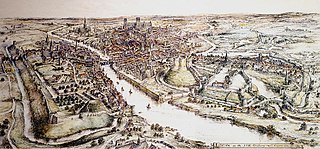
A motte-and-bailey castle is a European fortification with a wooden or stone keep situated on a raised area of ground called a motte, accompanied by a walled courtyard, or bailey, surrounded by a protective ditch and palisade. Relatively easy to build with unskilled labour, but still militarily formidable, these castles were built across northern Europe from the 10th century onwards, spreading from Normandy and Anjou in France, into the Holy Roman Empire in the 11th century. The Normans introduced the design into England and Wales. Motte-and-bailey castles were adopted in Scotland, Ireland, the Low Countries and Denmark in the 12th and 13th centuries. Windsor Castle, in England, is an example of a motte-and-bailey castle. By the end of the 13th century, the design was largely superseded by alternative forms of fortification, but the earthworks remain a prominent feature in many countries.

A concentric castle is a castle with two or more concentric curtain walls, such that the outer wall is lower than the inner and can be defended from it. The layout was square where the terrain permitted, or an irregular polygon where curtain walls of a spur castle followed the contours of a hill.

Sahyun Castle, also known as the Castle of Saladin, is a medieval castle in northwestern Syria. It is located 7 km east of Al-Haffah town and 30 km east of the city of Latakia, in high mountainous terrain on a ridge between two deep ravines and surrounded by forest, the site has been fortified since at least the mid 10th century. In 975 the Byzantine Emperor John I Tzimiskes captured the site and it remained under Byzantine control until around 1108. Early in the 12th century the Franks assumed control of the site and it was part of the newly formed Crusader state of the Principality of Antioch. The Crusaders undertook an extensive building programme, giving the castle much of its current appearance. In 1188 it fell to the forces of Saladin after a three-day siege. The castle was again besieged in 1287, this time both defender and belligerent were Mamluks. In 2006, the castles of Qal'at Salah El-Din and Krak des Chevaliers were recognised as a World Heritage Site by UNESCO. The site is owned by the Syrian government.
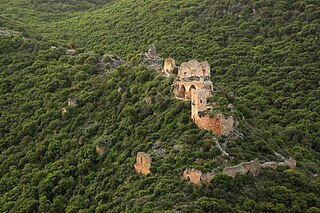
Montfort is a ruined Crusader castle in the Upper Galilee region in northern Israel, about 22 miles (35 km) northeast of the city of Haifa and 10 miles (16 km) south of the border with Lebanon.
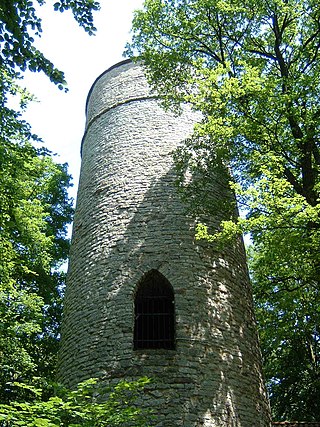
Grubenhagen Castle is a ruined medieval castle in North Germany dating to the 13th century. It is not far from the town of Einbeck in southern Lower Saxony.

A bailey or ward in a fortification is a courtyard enclosed by a curtain wall. In particular, an early type of European castle was known as a motte-and-bailey. Castles can have more than one bailey. Their layout depends both on the local topography and the level of fortification technology employed, ranging from simple enclosures to elaborate concentric defences. In addition to the gradual evolution of more complex castle plans, there are also significant differences in regional traditions of military architecture regarding the subdivision into baileys.

Bergfried is a tall tower that is typically found in castles of the Middle Ages in German-speaking countries and in countries under German influence. Friar describes it as a "free-standing, fighting-tower". Its defensive function is to some extent similar to that of a keep in English or French castles. However, the characteristic difference between a bergfried and a keep is that a bergfried was typically not designed for permanent habitation.

A fortified tower is one of the defensive structures used in fortifications, such as castles, along with curtain walls. Castle towers can have a variety of different shapes and fulfil different functions.
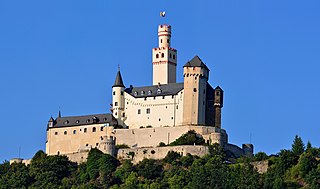
A hill castle or mountain castle is a castle built on a natural feature that stands above the surrounding terrain. It is a term derived from the German Höhenburg used in categorising castle sites by their topographical location. Hill castles are thus distinguished from lowland castles (Niederungsburgen).

The term lowland castle or plains castle describes a type of castle that is situated on a lowland, plain or valley floor, as opposed to one built on higher ground such as a hill spur. The classification is extensively used in Germany where about 34 percent of all castles are of the lowland type.

A hilltop castle is a type of hill castle that was built on the summit of a hill or mountain. In the latter case it may be termed a mountaintop castle. The term is derived from the German, Gipfelburg, which is one of a number of terms used in continental castellology to classify castles by topology. The chief advantage of such a strategically selected site was its inaccessibility. The steep flanks of the hill made assaults on the castle difficult or, depending on the terrain, even impossible. In addition, it often commanded excellent fields of view and fire over the surrounding countryside. The sheer height of the castle above the local area could also protect the occupants of the castle from bombardment. In addition, the prominent location of such a castle enhanced its status as a residence.

A ridge castle was a medieval fortification built on a ridge or the crest of mountain or hill chain. It was one of several types of hill castle.

A hillside castle is a castle built on the side of a hill above much of the surrounding terrain but below the summit itself. It is thus a type of hill castle and emerged in Europe in the second half of the 11th century. As a result of the particular danger to the site from attacks on the castle from the rising ground above it, this weak point is usually strongly protected by a shield wall or a Bergfried. Often a combination of these two passive defensive works were used.
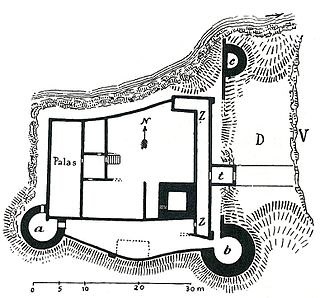
A neck ditch, sometimes called a throat ditch, is a dry moat that does not fully surround a castle, but only bars the side that is not protected by natural obstacles. It is often an important element in the defensive system of hill castles, especially in Germany and other parts of Central Europe.

"Zwinger" is a German word for outer ward or outer bailey. It represents an open kill zone area between two defensive walls that is used for defensive purposes. Zwingers were built in the post-classical and early modern periods to improve the defence of castles and town walls. The term is usually left untranslated, but is sometimes rendered as "outer courtyard", presumably referring to the subsequent role of a Zwinger as a castle's defences became redundant and it was converted into a palace or schloss; however, this belies its original purpose as a form of killing ground for the defence. The word is linked with zwingen, "to force", perhaps because the Zwinger forced an enemy to negotiate it before assaulting the main defensive line. Essenwein states that the "main purpose of this feature was so that the besieging force could not reach the actual castle wall very easily with battering rams or belfries, but had to stop at the lower, outer wall; also that two ranks of archers, behind and above one another, could fire upon the approaching enemy".

Schlüsselstein Castle was a castle and the seat of a noble family, probably dating to the High Middle Ages, the remains of which lie above the town of Ebermannstadt in the Upper Franconian county of Forchheim in the south German state of Bavaria. The site is known locally as Burgstall Schlüsselstein.

The burgstall of Schlossberg Castle, also called the Burgstall on the Flöss or the Heidenstein, is a now levelled, probably high mediaeval, nobleman's castle. It is situated above Haidhof, a village in the municipality of Gräfenberg in the Upper Franconian county of Forchheim in the south German state of Bavaria.
